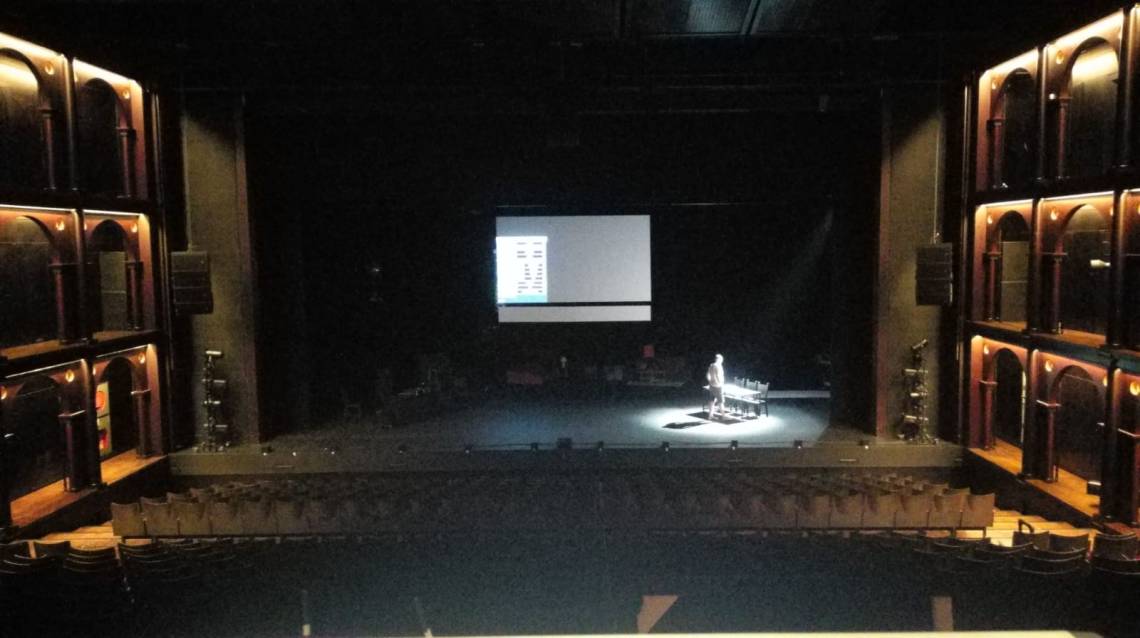
Milo Rau’s Histoire(s) du Théâtre 1 – La Reprise piece was shown at the GREC festival in Barcelona, not far from Toulouse. A great opportunity to try out the WFS system instead of the regular FOH system with an extra pair of speakers upstage.
The sound desig for the show was done a very common PA with a FoH L-C-R with extra front fills in mono. An extra pair of speakers is hung on both sides of a screen on which are projected recorded media and live camera interviews of the actors on stage.

The comedians are wearing necklace microphones by DPA (d:screet 4561). These microphones are lavaliers mounted in a a necklace so that there are no microphones visible on the close up videos of the actors on stage. They can also be taken off and put back on very fast with only a clasp to handle. But the microphones are very sensitive to feedback since they are placed on the top of the chest a bit far from the mouth. And the tone of the voices changes greatly with the position of the comedian especially when they lean forward or tilt their head up or raise their arms in front of themselves… It may be a good microphone choice for video and film productions, not so much for live shows.
At some point the comedians’ voices are also picked-up by a boom microphone. One of them plays a depressed mother who has had her son murdered. Usually her voice is amplified by the screen speakers that are right behind her since she is filmed at that point. With the speakers are in line behind her this causes much feedback.
In agreement with the technical manager of the company with whom I share the sound management we decided to give WFS a try to solve feedback issues and the placement of the amplified voices. In the end we want to have greater intelligibility of the text that’s in Flemish (Dutch), French and English. The choice of what languages are used for surtitles depends on the venue where we give the show.
The QLab project was modified to have the localisation parameters for the voices of the actors, the screen and all the pre-recorded sounds. With a regular sound system each output of QLab can represent a speaker : FoH Left and Right, upstage Left and Right. With WFS it is important to have the different tracks individually for placement. In the end there was a track for the screen position, a pair for ambient sounds and music, and a few more for extra Foley sounds in different places.
Without so much difficulties it is possible to place the voices of the comedians according to their position. Since each show is slightly different it is necessary to be able to make small adjustments to their precise location and level.
Ambient sounds and music can now fill the space. The regular PA of the venue is used mostly for louder music, for instance in a disco scene. For the rest it’s ten small KS Audio CPD04 speakers at the lip of the stage and four slightly larger KS Audio CPD08 flown at the proscenium and that cover most of the 500 seats of the house.
During the scene where the actors are filmed live their voice should appear as coming from speakers placed next to the screen. But now with WFS there no longer are any there! If you keep the settings with the screen where it is the acoustic voice of the actors will be 2m ahead and be understood as the location by our hearing. But if you activate the « minimal latency » mode all delay line are reduced by the amount of the shortest one. In this case the time curvature corresponds to the distance to the screen but it comes out before the natural voice of the actors. Because of the Hass effect the amplified voice covers the acoustic voice. And so the voice is perceived as coming from the screen.
Of course the comedians found that with this sound system their usual sound cues and mutual relations felt very different. When you are sitting in the house you really feel as if the whole stage is bathed in sound but it is not when you are standing on stage. With a small monitor placed in the middle at the front of the stage and a small speaker placed behind the sofa upstage-left I could give the actors some of the music and ambient sounds and a little of the voices too so they felt more in the same sonic environment. The levels were set so as not to disturb the WFS system and give them enough presence on stage.

In the end a very promising experiment after a couple of rehearsals and shows. To be continued…
Shows using WFS :
Théâtre de Liège, Belgium – Octobre 5th till 7th 2022
Théâtre de la Cité – CDN de Toulouse – Decembre 7th till 9th 2021
Comédie de Valence (CDN) – February 19th and 20th 2020
Théâtre de Cornouaille – Scène nationale de Quimper – Decembre 5th and 6th 2019
Théâtre National de Bordeaux Aquitaine (CDN) – July 3rd and 4th 2019
Le Manège – Scène nationale de Maubeuge – May 16th and 17th 2019
Le Lieu Unique – Scène nationale de Nantes – from January 9th till 11th 2019
Théâtre Nanterre-Les Amandiers – (CDN) from Septembre 21st till Octobre 5th 2018
Teatre Lliure de Montjuïc – Barcelona – July 29th and 30th 2018
J’aimeJ’aime